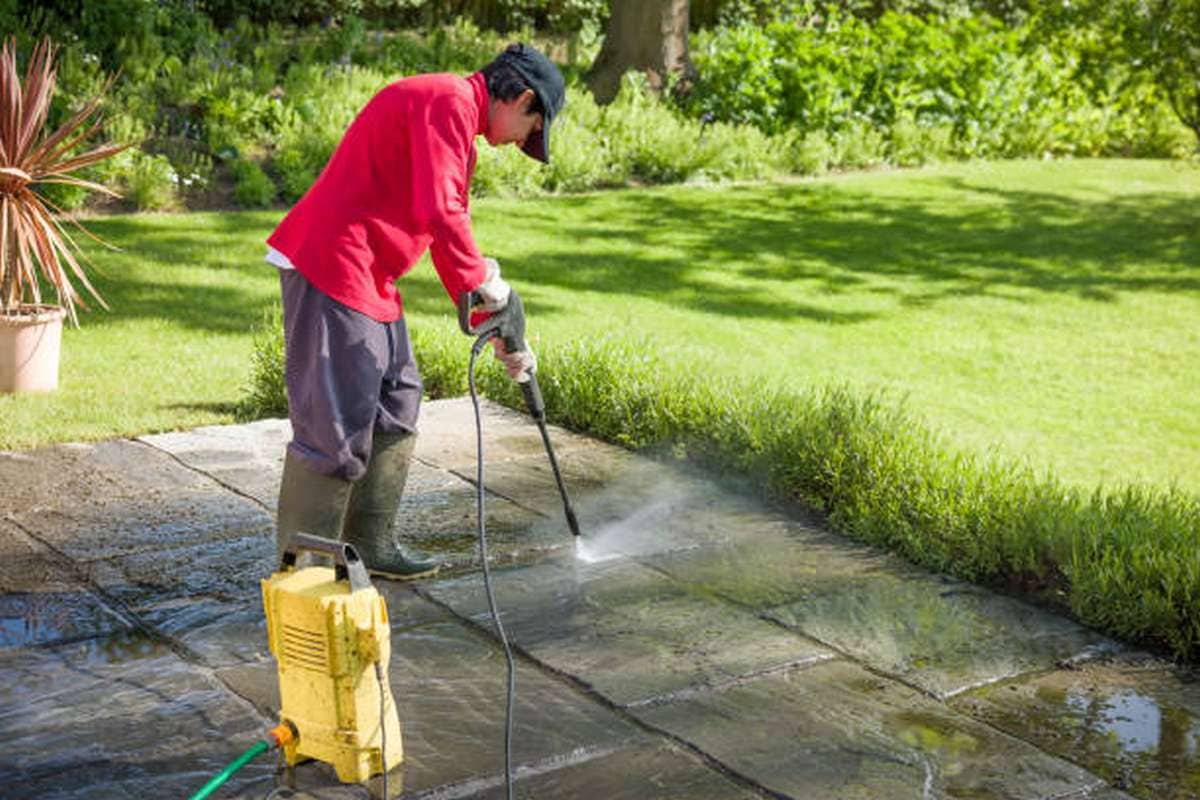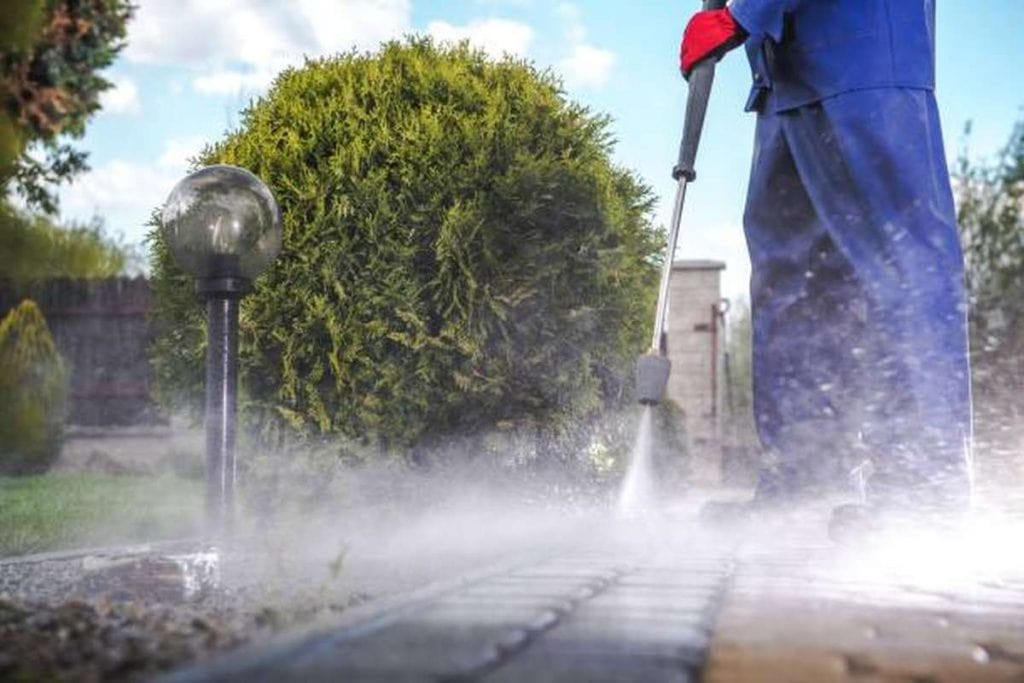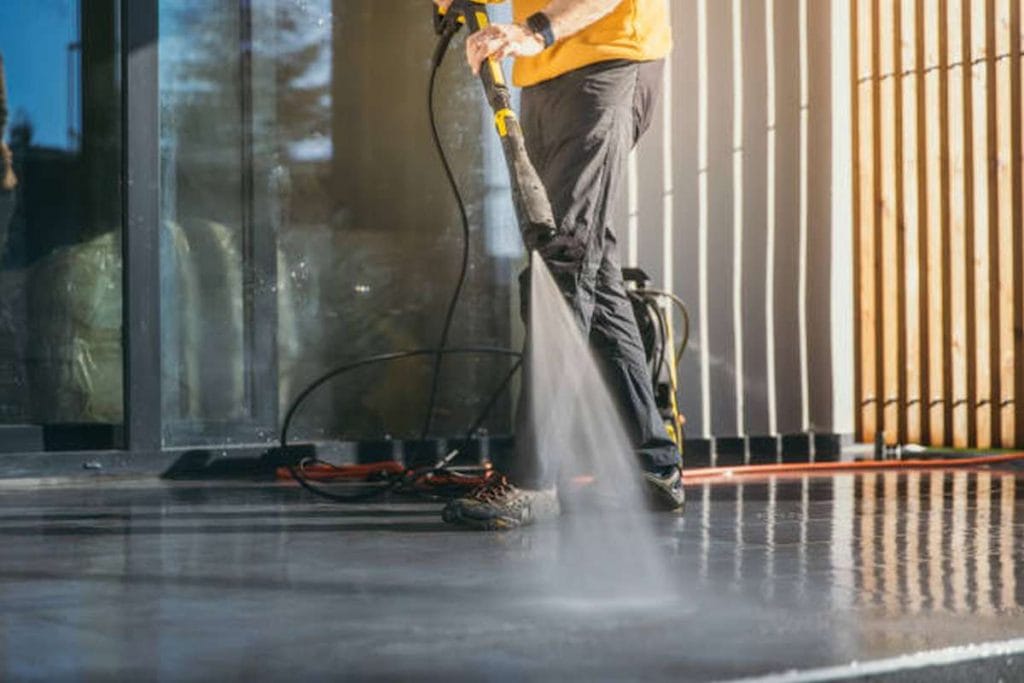Maintaining a concrete driveway can be an overwhelming task, especially if you're not sure where to begin. After all, a well-maintained driveway adds beauty and value to your home. But without the right approach, it can quickly become dull, stained and unsightly–not to mention costly!
Luckily, there are some easy steps anyone can take to care for their concrete driveway on an ongoing basis. In this blog post we'll discuss how you can protect and enhance your concrete drive with simple DIY tasks so you keep it looking its best over time. Read on to learn more!
Important Precautions To Take When Maintaining A Concrete Driveway

In the future, if you perform some routine maintenance, your driveway will last even longer. All it takes is a few hours of effort per season and implementing a few basic maintenance procedures.
Repairing Damaged Concrete
Before water or winter weather worsens the problem, it is necessary to treat any areas where the concrete is cracked or where chunks have come off. Use concrete patching compound to seal fractures and holes in concrete to stop future deterioration.
Begin by sweeping the driveway and then washing it with a pressure washer to eliminate any remaining dirt and debris. The next step is to apply the patch and wait for it to dry. After that, follow these steps to seal the concrete.
Unsealed cracks inside the expansion joints connecting the individual sections or concrete can cause just as much trouble. If water is getting in through these cracks, wipe them out and seal them with silicone caulk designed for concrete.
Keep The Driveway As Dry As Possible
Create a runoff area of snow and water by clearing a two- to three-inch margin around the outer corners of the driveway. Additionally, check that the downspouts are directed away from the driveway and into the yard.
The Driveway Must Be Sealed To Prevent Cracking.
Driveways benefit greatly from the durability of concrete. However, the presence of even a single factor might be disastrous for concrete. For example, a crack in the concrete's surface allows water to seep in, freeze in the winter, and expand. Because of this, cracks can propagate rapidly. They can expand considerably in length and breadth in a single Ohio winter.
Right now is the prime time to get ready for the coming of winter. To delay the inevitable, put concrete sealant on your driveway this season. Applying a sealant to a driveway that has never been sealed before will prevent water damage and preserve the concrete.
First, you must power wash your driveway to remove the grime, dirt, and tree sap. Afterwards, use a pavement and asphalt cleaning chemical available at the local hardware shop to remove the set-in stains caused by the oil and grease. Once you're satisfied with the seal, you can finish up. Hardware stores and home improvement centres typically stock high-quality commercial sealers.
Although the dry-look sealer is much more expensive, it provides up to 10 years of protection since it is incorporated into the concrete.
Wet-look seal is much less expensive and advantageous because it prevents grease and grease stains, but it needs to be renewed every three to five years.
Removing Snow Cautiously
Applying salt or other chemical deicing chemicals on your concrete driveway when it freezes in the winter may be a good idea, but doing so might cause damage. The melting and refreezing of ice causes scaling and spalling in the concrete, a common result of deicer use. Also, in the first winter, after new concrete has been put in, it is especially necessary to avoid using salt or chemical agents, which can erode the surface.
Sand or cat litter can be sprinkled on a concrete driveway for traction without damaging the surface. It would help if you used a plastic snow shovel or a snow blower when clearing snow. Avoid scratching the driveway's surface by not applying pressure as you move the snowblower across the ground. Also, avoid using shovels or sharp implements to chip away at the icy driveway.
Scaling and spalling can occur if you use deicers on a concrete driveway during the winter. To make matters worse, fresh concrete is especially vulnerable to the effects of salt. De-icing chemicals can cause damage to concrete structures because they accelerate the thawing or refreezing of water moisture in the material. As a result, cracks will likely appear. Ammonium sulphate and nitrate are chemically destructive to concrete and should be avoided. Calcium chloride and rock salts (sodium chloride) are less destructive, but they still represent a risk to plants and can corrode metal. To properly grip the ground, sand could be a preferable option.
Park With Caution
It may come as a surprise, but large vehicles aren't meant to be driven down a driveway. Whenever there's too much pressure on an edge, it will chip. So you should park far from the kerb and prohibit the use of the area by construction equipment and other vehicles when working on your home's exterior.
While it's true that concrete is quite sturdy, it's not indestructible. The driveway's concrete is weakest towards its borders, so try not to drive over them or park over them. Keep construction vehicles and heavy machinery parked far from the driveway's edge.
Maintain A Tidy Environment
Concrete may absorb oil, gas, and grease up to a quarter of an inch, leaving a lasting mark. So even if your driveway is sealed, you should immediately remove any stains to keep it looking nice.
If any liquid has made its way to the concrete's surface, you can brush it off by covering the area with sawdust or cat litter. Please wait at least a day for it to absorb any oil or grease fully. Then, use a power washer and some specific grease-cutting, biodegradable detergents to clean up the stained areas of the concrete.
Your Driveway Needs To Be Replaced.
The driveway will have to be replaced when it grows too old or is damaged. Removing only the damaged areas and filling the gaps using new concrete works, but the bond is weak, and the colours may not match due to the use of various aggregates. If the damage goes further into the concrete body, rebuilding the surface might not be cost-effective. On the other hand, your concrete driveway may not be holding up as well as it should, so start from scratch to replace it.
A Guide To Choosing A Sealant

Maintaining a concrete driveway includes picking a good sealer. There are two varieties available. When sealing, you can choose between a "wet" or "dry" appearance. Unfortunately, there are significant distinctions between these items despite their same functionality.
This Is What Wet-Look Sealers Are All About
When applied on concrete, a "wet" look sealer will leave a coating on the driveway's surface. In this method, the surface will appear wet even after drying.
This concrete driveway sealant helps prevent oil and grease from penetrating the surface. It's cheaper than other sealants but needs to be applied often.
This Is What Dry-Look Sealers Are All About
Employing a sealer that gives the concrete a "dry" appearance is equivalent to using a substance that seeps and permeates the material. This will not only provide a more robust shield but will also prevent the driveway from being discoloured. There is a price premium over "wet" seeming sealer because it can last up to ten years.
Concrete driveway maintenance frequency should be considered when deciding between the two options. Choosing the "dry" looking driveway sealer may not be the best option if you are on a budget. However, this concrete driveway sealer may be the most affordable option over time. We want to minimise the need for concrete driveway repair due to cracking. Therefore that's our end goal.
Conclusion
Concrete's long life span makes it ideal for driveways. Water seeps through a fracture in the concrete's surface, freezes and expands throughout the winter. The inevitable deterioration of your driveway might be postponed this season by applying concrete sealer on it. A driveway that has never been sealed before can be protected from water damage and extended the life of the concrete by having a sealant applied to it. Traction can be added to a concrete driveway with sand or cat litter without hurting the surface.
Because they hasten the thawing and refreezing of water moisture in the material, de-icing chemicals can cause damage to concrete structures. Avoid using ammonium sulphate and nitrate because they deteriorate concrete chemically. Sand may be prefered to other options for providing adequate traction. Even though it's really strong, concrete can still be broken. Please avoid driving or parking on the edges of the driveway as this is where the concrete is the weakest.
Heavy equipment and construction trucks should be parked well away from the kerb. A paved driveway still requires regular maintenance, including the removal of spills as soon as they occur. Sealant for concrete driveways comes in two different types. Using a sealer that leaves the concrete seeming "dry" is the same as saturating it with a liquid. This will serve as a stronger protection and keep the driveway from becoming discoloured.
Content Summary
- Your driveway will endure even longer in the future if you maintain it regularly.
- It only takes a few hours of work per season and the use of certain fundamental maintenance methods to keep things running well.
- Any spots where the concrete is fractured or where pieces have broken off must be treated before water or cold weather exacerbates the situation.
- To prevent further deterioration of concrete, cracks and holes should be sealed using concrete patching material.
- Before using a pressure washer, sweep the driveway to remove any loose dirt and debris.
- When the patch has dried, it can be applied.
- Next, proceed as follows to seal the concrete.
- The expansion joints between individual pieces of concrete might also develop leaks if they aren't properly sealed.
- Caulk the cracks with concrete-specific silicone if water is leaking in.
- Clear a two- to three-inch gap around the driveway's outer edges to act as a runoff area for snow and water.
- Be sure the downspouts are pointing towards the yard and not the driveway as well.
- If you don't seal your driveway, it will crack.
- Concrete's long life span makes it ideal for driveways.
- On the other hand, the presence of even a single component could be extremely detrimental to the concrete.
- Water can seep in through a crack in the concrete's surface, freeze in the winter, and then expand.
- It's because of this that cracks can spread so easily.
- Over the course of a single Ohio winter, they can grow to impressive proportions.
- As winter approaches, now is the time to make preparations.
- The inevitable deterioration of your driveway might be postponed this season by applying concrete sealer on it.
- A driveway that has never been sealed before can be protected from water damage and extend the life of the concrete by having a sealant applied to it.
- Power-washing the driveway is the first step in getting rid of the grime, dirt, and tree sap that have accumulated over time.
- When the oil and grease stains have set in, apply a pavement and asphalt cleaning agent from the hardware store to get rid of them.
- The dry-look sealer is more costly but lasts longer than the wet-look sealer (up to 10 years) since it is mixed into the concrete.
- While wet-look seal is helpful and cost-effective, it must be reapplied every three to five years to continue protecting against grease and grease stains.
- Careful Snow Removal When your concrete driveway freezes over in the winter, it may seem like a good idea to apply salt or other chemical deicing agents to it, but doing so could really cause damage.
- Scaling and spalling in the concrete are common side effects of using deicers because of the ice melting and refreeze.
- Avoid applying salt or chemical agents, which can erode the surface, especially during the first winter after fresh concrete has been put in.
- Traction can be added to a concrete driveway with sand or cat litter without hurting the surface.
- A plastic snow shovel or snow blower would be useful for this task.
- You can keep the driveway unscathed by avoiding pressing down too hard on the ground as you drag the snowblower.
- Don't use shovels or anything sharp to chisel away at the driveway's ice, either.
- Using deicers on a concrete driveway can lead to scaling and spalling throughout the winter.
- The problem is exacerbated by the fact that fresh concrete is especially susceptible to the impacts of salt.
- Because they hasten the thawing and refreezing of water moisture in the material, de-icing chemicals can cause damage to concrete structures.
- Cracks will emerge as a result.
- Avoid using ammonium sulphate and nitrate because they deteriorate concrete chemically.
- It's true that calcium chloride and rock salts (sodium chloride) are less harmful, but they still pose a threat to plants and can corrode metal.
- Sand may be preferred to other options for providing adequate traction.
- Large vehicles aren't designed to be driven down a driveway, which may come as a surprise to some.
- When an edge is stressed enough, it chips.
- When doing exterior work on your property, you should park well away from the kerb and forbid the use of the area by construction equipment and other vehicles.
- Although concrete is fairly strong, it can still be broken.
- Please avoid driving or parking on the edges of the driveway as this is where the concrete is the weakest.
- Heavy equipment and construction trucks should be parked well away from the kerb.
- As much as a quarter of an inch of oil, gas, or grease can be absorbed into concrete, producing a permanent stain.
- So even if your driveway is sealed, you need to immediately remove any stains to keep it looking great.
- Sawdust or cat litter can be used to brush away liquid that has made its way to the surface of concrete.
- Wait at least a day for it to absorb any oil or grease thoroughly.
- Then, clean the soiled concrete with a power washer and some grease-cutting, biodegradable detergents.
- It's time to replace your driveway.
- When the driveway becomes too worn or damaged, it will need to be replaced.
- Removing only the damaged parts and filling the gaps using new concrete works, but the bond is weak, and the colours may not match due to the use of diverse aggregates.
- It may not be cost-effective to restore the surface if the damage extends further into the concrete body.
- However, if you see that your concrete driveway isn't holding up as well as it should, you may want to start over and redo it from the ground up.
- Choosing a quality sealer is an important part of keeping a concrete driveway in good condition.
- There are two distinct types to choose from.
- When sealing, you have the option of going for a "wet" or "dry" look.
- While they serve the same purpose, these products are not interchangeable due to major differences.
- Here, you can see why wet-look sealers are so useful. A "wet" look sealer, when applied to concrete, will leave a layer on the driveway.
- After curing, the surface will still have a slick appearance when using this technique.
- This sealer for concrete driveways helps keep oil and grease on the surface where it belongs.
- It needs to be applied frequently but is less expensive than other sealants.
- All of this is why you need dry-looking sealers. Using a "dry" looking sealant is the same as using a chemical that seeps and penetrates the concrete.
- This will serve as a stronger protection and keep the driveway from becoming discoloured.
- It costs more than sealer, which gives the impression of being "wet," but it can endure for up to ten years.
- The two choices have different merits, and it is important to think about how often you want to maintain your concrete driveway before making a final decision.
- A driveway sealer that appears "dry" may not be the ideal choice if you're trying to save money.
- It's possible, though, that this concrete driveway sealer will end up being the least expensive alternative in the long run.
- We wish to decrease the need for concrete driveway repair due to cracking.
- Therefore, that's what we're shooting for.
FAQs About Concrete Driveway
Seal the Concrete. After the concrete has dried for at least 24 hours, you can effectively apply a concrete sealer. A sealer helps prevent future stains and potential damage from products like ice salts. Some sealers leave the surface with a shiny finish while others have a matte finish.
Concrete driveway sealing is an important part of keeping your driveway in good condition. Sealing helps to protect the concrete from weathering, staining, and other damage. It also makes it easier to clean and maintain.
Outdoor concrete sealers are not only worthwhile but necessary. Experts who recommend having a concrete surface sealed are doing their customers a big favour. Without this extra layer of protection, concrete will absorb moisture and may begin to crack, spall, flake, and discolour, among other things.
Sealing a driveway could yield unwanted consequences: Oil from the bitumen (the black glue that holds the asphalt together) will be tracked into the home, or the sealant could wear away unevenly, making the surface look as if it's peeling.
It depends on the project, but many homeowners with concrete driveways find it easy and cost-effective to seal themselves. Solids, epoxies, and urethanes 50% or under are often applied DIY, but 100% solids, epoxies, and urethanes require special tools and professional application.




